Corsair Gaming M65 Pro RGB Mouse Review
Pros
Cons
Rating
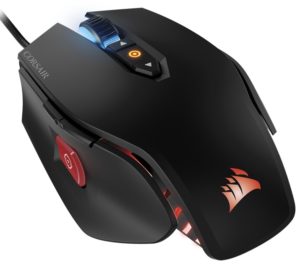
Introduction
Here at TBG, we’ve been keeping a watchful eye on gaming mouse tech for a while. In our most recent article on the subject, we conducted an extensive comparison of many top-selling models. In that shootout, the Logitech G502 Proteus Spectrum came out on top, with the Corsair Raptor M45 landing somewhere in the middle. We liked the M45’s styling and thought it offered a good shape for intense gaming, but it was a bit behind the times in terms of its responsiveness and LED lighting effects.
Enter the Corsair Gaming M65 Pro RGB. Its name is a mouthful, but it hints at all the upgrades that Corsair has packed into this model, which actually uses a very similar overall design to the now-discontinued M45 we last tested. The M65 Pro, not to be confused with the two-generations older M65 or the last-gen M65 RGB, offers one major upgrade over its M65 forebears: an optical sensor, much like the M45. Yes, we know what you’re thinking… why has Corsair gone to an optical sensor, such as the one used in its discontinued M45, when the M65 model lineup has up to this point used laser sensors? Well, we have a feeling that it has to be do with the inherent benefits that optical sensors offer in high-speed tracking. Laser sensors are great for a lot of things, including in some applications being able to track on glass, but optical sensors, which have been around for quite some time, are now the favored solution for gamers.
But Corsair didn’t fall back on the 5,000 dpi optical sensor used in the M45. No, it went all out with the M65 Pro RGB, picking up a top-of-the-line 12,000 dpi optical sensor, which matches or beats every other major gaming peripherals manufacturer, other than Razer and the insane 16,000 dpi sensor used in the Mamba. But let’s be clear: we’re not going to get caught up in the numbers game. Just like in the digital camera world, where the megapixel war has become a punchline, when it comes to gaming mice, there’s a lot more to success than the dots per inch capability of your mouse.
So let’s jump right into it then, checking out what the M65 Pro RGB offers both in terms of features and performance!
We’d like to extend a special thank you to Corsair for providing us with a review sample of the M65 Pro RGB Mouse and MM300 Extended Mouse Mat.
Description and Features
The new M65 Pro RGB incorporates all the very best features from previous Corsair mice, including an ergonomic gaming grip, aluminum chassis with weight tuning, a sniper button, RGB lighting, and adds a pro-grade optical sensor. As we explained above, that is arguably an enhancement over the laser sensor in the standard M65. While “laser” does sound higher-tech, gamers have found over the years that it doesn’t track as true as a good optical sensor. And Corsair is using a very good optical sensor in this mouse. What’s most amazing about Corsair packing all of these features into the M65 Pro RGB? The price. This new model is available for just under $60, which is right in line with the mid-range offerings from many manufacturers. Corsair has always been competitive when it comes to the pricing of its gaming mice, and the M65 Pro RGB is no exception. But when it comes right down to it, performance and feel is what really matters, and we’ll soon see how the M65 Pro RGB does! By the way, we’ll be testing the M65 Pro on Corsair’s awesome MM300 Extended Mouse Mat, which should really be referred to as a desk mat. It’s big enough to hold your keyboard, mouse, and other gear, and looks fantastic doing it!
We tested Corsair’s latest gaming gear out on the following test system:
- CPU: Intel Core i7-5820K @ 4.4GHz
- Motherboard: Asus X99-Pro/USB3.1
- Video Card: EVGA GeForce GTX 980 Ti ACX 6GB
- RAM: G.Skill 4x8GB Ripjaws V DDR4-2666
- SSD #1: Samsung SM951 M.2 256GB
- SSD #2: 2x Samsung 850 Evo 500GB in RAID0
- Case: Corsair Carbide 500R
- Power Supply: EVGA Supernova 1000 PS
- CPU Cooler: Corsair Hydro H100i v2
- Operating System: Windows 10
To control all the lights and buttons, as well as the M65’s performance traits, we downloaded Corsair’s CUE software from the Corsair website. It’s absolutely required to use the M65 Pro RBG to its fullest, but take note that it’s not included in the box. The application is quite comprehensive, and we were most impressed with the ability to individually tailor not just dpi, but also polling rate and mouse cursor speed. Corsair has also added a handy utility to allow the user to tune the mouse to specific mousing surfaces, which we found made a very significant difference in terms of feel. Unfortunately, the software continues to have a lot of rough edges, despite being many revisions in at this point. This is probably in part due to the fact that Corsair has been adding new peripherals and features faster than its coders can adeptly add them to the software package. As you can see in the screenshot below, there is a main Lighting menu, which counter-intuitively has nothing to do with mouse lighting, and then there’s a Lighting sub-menu under the Profiles menu that actually allows you to control lighting of the mouse. How about a Mouse, Keyboard, and Headset menu instead, Corsair?

And while all this works well enough once you’ve sorted through all the menus, there’s one more counter-intuitive aspect to the M65 Pro’s lighting setup: it has three zones, but only two (front and back) are coordinated. For some unknown reason, the DPI selection light has its own lighting routine, displaying one of five colors for each of the five DPI presets. And this, quite frankly, makes no sense, as it’s impossible to remember which color corresponds to which DPI setting in the heat of the battle, and the time-tested multiple “light bars” that Corsair uses on the standard M65 Mouse works so much better. Plus, you could then coordinate the color to the rest of the mouse. Seriously, Corsair, fix this in the next version!
The good news is that the DPI selector buttons work just fine, and we really like that there are five individual presets available as you scroll through the settings, and furthermore, than unlike some of Corsair’s competitors, the selections don’t cycle through to the lowest setting as you keep scrolling through. In the heat of the battle, the last thing you want is to try to increase your speed only to find that you’ve just selected your 800dpi preset! The other thing we really like is the side-mounted sniper button. In a slight update from the original M65, the sniper button was moved further back on the mouse chassis, and for us it really did sit right under the thumb. If pressed and held while gaming, it allows for ultra-precise movements. The nice thing about this button is that it will not maintain ultra-low dpi when released. That’s critical to avoid mishaps while just passing your thumb over the button momentarily during gaming sessions (which, alas, is going to happen from time to time).
We also really love the scroll wheel on the M65, which is vastly superior to every other scroll wheel we’ve tried. First, it has a grippy rubber surface (Logitech inexplicably moved to slippery metal on its latest model), and it also has a concave surface, making it a perfect match for the convex fingers that every human is born with! This is an innovation that was a long time coming, but strangely enough, only Corsair has caught on to it!
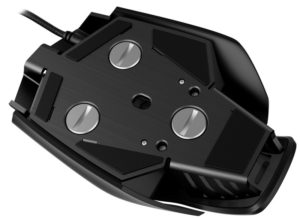
Also working in Corsair’s favor are the impressively-large and nicely-spaced PTFE glide pads on the bottom of the M65 Pro RGB, easily the best we’ve seen among any major manufacturer. Some use pads that are simply too small, and some have them unevenly spaced around the mouse, leading to drag when moving in one direction or the other. Corsair’s M65 suffers from none of these issues. And the M65 Pro RGB is also quite tunable, in that it has three weights that can be added or removed to further improve the balance and feel of the mouse in a particular user’s hands. In our opinion, however, Corsair shouldn’t ship the M65 with the weights pre-installed, as it’s simply too heavy for the average user. Logitech has Corsair beat here in shipping its gaming mice with a box of weights that can be added at the user’s convenience.
And alas, Corsair grasps defeat from the jaws of victory in sticking with its antiquated, barely-passable forward/back buttons on the side of the mouse. In addition to being used for navigation in Windows, these buttons are often mapped to critical functions in games. The tiny buttons being used by Corsair are a throwback to the mid-2000s when such buttons first appeared on mice, and betrays the fact that the M65 is ultimately built upon a fairly old chassis.
Performance
In case it wasn’t obvious, we weren’t going to just review the M65 in a vacuum. No, we put it up against our runner-up and winning mice from our recent peripherals roundup: the Razer Deathadder Chroma and Logitech G502 Proteus Spectrum, respectively. All three mice can be seen below, with the Corsair on the left, Razer in the middle, and Logitech on the right.
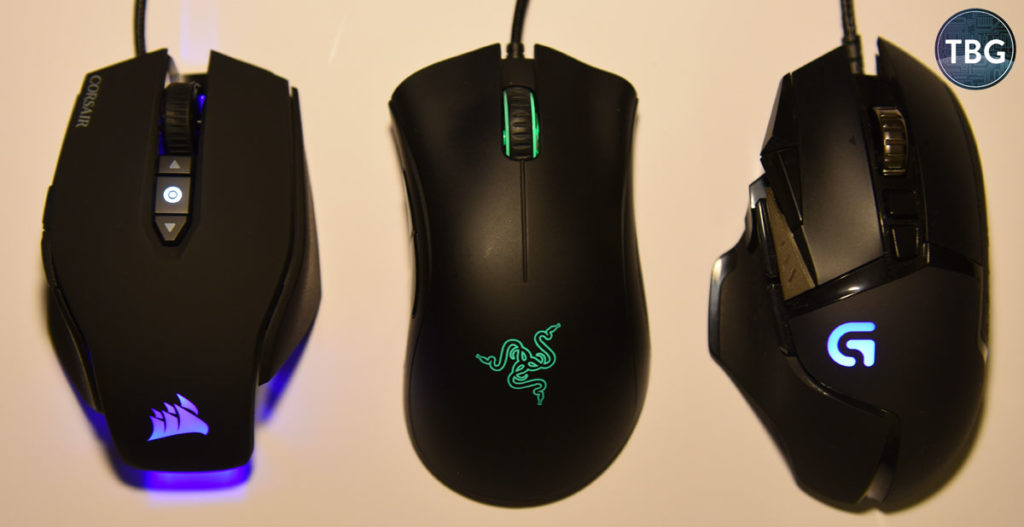
We’ve already established that the Corsair M65 wins in terms of some features and loses in terms of others, but we should point out that overall, its lighting effects are really quite competitive, and we particularly like that due to the open-style metal frame it uses, it casts light both up through the chassis and down onto the mousing surface. This really puts it in another league in terms of aesthetics.
Now, how about performance? Well, so much about mouse performance comes down to feel, and this can be very much specific to the individual user. As our photo above makes clear, Corsair has blazed its own trail in terms of grip design, opting for a very wide, but relatively short and flat profile. From our point of view, this design invites an “active” grip, by which we mean something other than a palm grip where you’d have your entire hand draped around the mouse. With our palm resting on the pronounced hump on the rear of the mouse, only our fingertips touched the buttons. We really like this for gaming, although it’s really not ideal for casual or work usage scenarios. And for us, the body is just a tad wide: our ring finger could almost be perched up top alongside our middle finger, unlike other mice that force you to wrap around the side, but because the mouse isn’t quite wide enough to accommodate all three fingers, the ring finger never quite finds its place. During intense gaming, we think most users will wrap their ring finger around the side, but that makes for a slightly stretched, off-balance grip.
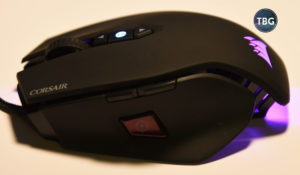
All of this is something users can probably get used to, as they do with every other mouse out there that isn’t custom-made for their hand (i.e., all of them!), and luckily, Corsair gets it right with the sensor and switches. The M65 Pro RGB tracks very true and very fast, and we liked it a lot more than the older M45, and at least as much as the Logitech G502 Proteus Spectrum. And the switches being used in for the left-and right-buttons are low actuation force, short-throw models, making them much quicker than those on competing mice.
In our very first online Battlefield 4 match using the M65 Pro RGB, we topped our 32-man team on the scoreboard, suggesting that the M65 did not cause us to miss a beat. In fact, we’d wager that it actually improved our gaming performance versus our daily gaming mouse, the Logitech G502. And it easily has the outdated Razer Deathadder beat. Yes, the Deathadder has a classic shape that has aged quite well, but it really is a 4-year-old design when it comes right down to it, and its tiny glide pads, lack of a dpi selector switch, and overly-low weight make it far from ideal from our point of view.
Conclusion
Ultimately, Corsair has done so many things right with the M65 Pro RGB. The new 12,000 dpi optical sensor is truly cutting-edge and gaming-grade, and the big, slick glide pads, low profile shape, and fast switches mean nothing’s going to slow you down when it comes to performance. We also really like the way the open aluminum frame allows the M65 Pro RGB to “light up the night”, providing far more spectacle than most RGB mice on the market today. Furthermore, the M65 has the best scroll wheel in the business; other manufacturers would be well-served in following Corsair’s lead in this regard. And the price? Incredible, undercutting every competitor offering anywhere near the range of features that the M65 Pro RGB does.
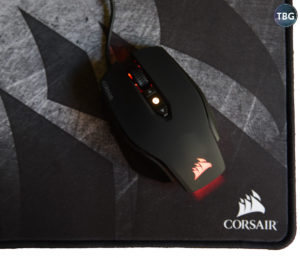
But Corsair stumbles in some familiar areas, and we imagine these are areas known to Corsair at this point. The thumb buttons are unacceptably-small for a gaming mouse released in 2016, and we’re shocked that Corsair hasn’t fixed this given that it’s released two iterations of the sniper button in the interim. Furthermore, Corsair’s CUE software, while comprehensive, is really a mess when it comes to navigation, and we think Corsair should start from scratch with it, which will allow Corsair to better integrate the peripherals it has on offer right now, which are clearly not fitting that well into the old menu system being utilized by CUE. Finally, the LED effects used on the DPI selection indicator are strangely out of sync with the rest of the mouse, and even worse, are nearly useless when it comes to actually indicating the DPI setting.
Overall, we really, really like the M65 Pro RGB, and for our play style, we actually prefer it to our reigning champ, the Logitech G502 Proteus Spectrum. The shape is more favorable to an aggressive grip style, and it glides so much more smoothly. It also looks better sitting on our desk, both due to the far more impressive lighting effects and the more subdued, professional style. But we think that for the average gamer, the G502 just barely keeps its title as the best overall gaming mouse, due to the more modern button array and a more universal grip design.
The Corsair M65 Pro RGB Gaming Mouse is available for $59.99 shipped from Amazon, as our publication date. For our top picks in every peripherals category, check out our Peripherals Buyer’s Guide, updated quarterly!

